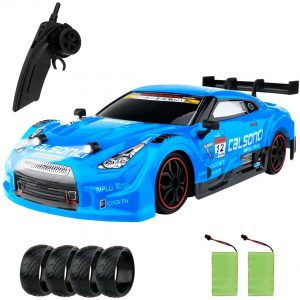Table of Contents
Introduction
RC cars can be quite thrilling and exciting. They are fast, fun, and controlled by a remote, making it even more fun. Driving an RC car is almost the same experience as driving a real one. It is also equipped with an engine, wheels and also uses fuel.
Driving an RC car is just as straightforward as driving a real one, but most people have issues with the drifting process. It isn’t as easy as just driving the car on a straight road. There will be a need to maneuver the car at sharp corners, which can be quite tricky, especially at top speed, while also avoiding collisions.
RC drifting is the process of oversteering your motor across and through various bends/turns and controlling your vehicle through sharp bends and corners without colliding into another vehicle or object and under minimal friction.
The first known RC car drifters were from Japan. Many people use electric RC models for drifting while some use gas or nitro powered RC car models. Some people who do not own drift RC cars go-ahead to modify and upgrade their RC vehicles to drift easily. This includes replacing the brakes, weight balance, tires, and shocks.
What you will need to drift
- Design
These remote-control drift cars come in various significant designs but can be quite expensive. But if you don’t own one, you can use LED lights, roll cages, and flared guards to design or paint it. This will help to add a unique touch to your RC car.
- Wheels
Low friction wheels will give you a level of control when you’re oversteering during the drifting process. It is advisable to use tires made with ABS plastics because they tend to last long. You can also use tires with PVC piping as they are physically rigid and sturdy. Both types of tires help to make sure that you are in control and are also less costly than models designed for drifting.
General rules of drifting and control skills needed
Certain guidelines come with driving RC cars. These rules have been set by drifting organizations like D1 Grand Prix. It is important to know and understand these guidelines so that you don’t break the rules.
Some of these criteria include;
Angle – exceeding and understeering inputs are monitored closely. Smooth transitioning, especially from opposite directions, are encouraged.
Line – This is usually identified by clipping areas. You’d need to get close to these zones when driving.
Drifting competitions may not have been divided into categories due to the various upgrades and modifications done to the cars. Some people even use parts from different manufacturers to upgrade their RC vehicles.
A skill that is essential in RC car drifting is counter steering. In most cases, the driving energy is steered to the back and front wheels. In drifting, most of the force is felt by the back wheels, making it turn faster than the front wheels. Therefore, you’d need to counter steer skills to help you remain in control.
Drifting doesn’t require specific areas to do so on. All you need is a spacious and wide, smooth surface, where you can practice drifting. If you have access to a local road track, you can also join in drift competitions but note that judgment will be based mostly on speed, racing line, and drift angle when drifting in drifting competitions.
How to drift an RC car
As the saying goes, “practice makes perfect.” If you want to be an expert drifter, you’d need to practice a lot and gain more experience. You can start drifting at the end of the second half of a corner. Below are some easy tips for drifting beginners.
- When you reach the peak of a corner, accelerate pretty hard to cause the rear to break free
- If your car begins to slide, maneuver your steering wheel to the opposite direction and use the throttle. Now, balance the drift till your controls begin to return to their former position
- Ensure that you drive on a straight line and be persistent with your throttle control. Do not change your direction too sudden to avoid unbalancing your RC car
Conclusion
Drifting RC cars is a fun hobby and may seem difficult at first but is quite enjoyable once you get the hang of it.
Also see;

